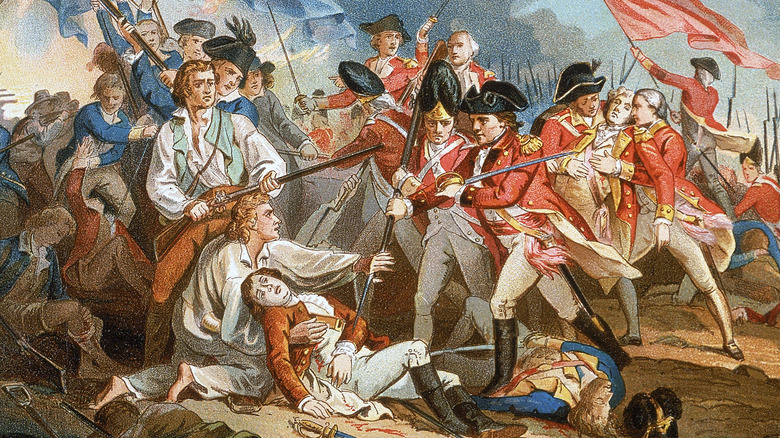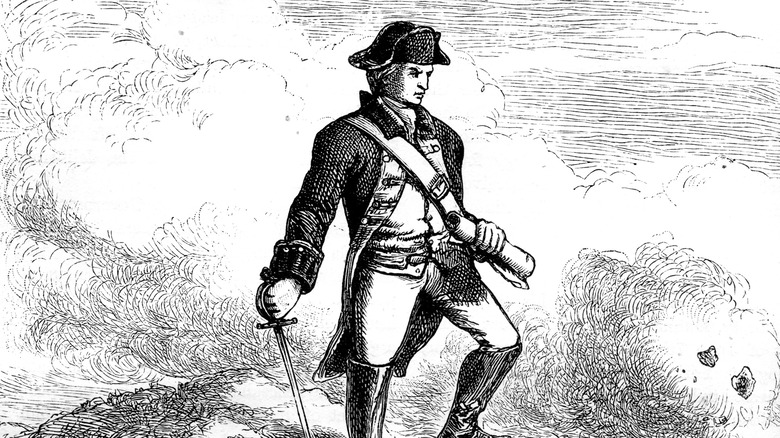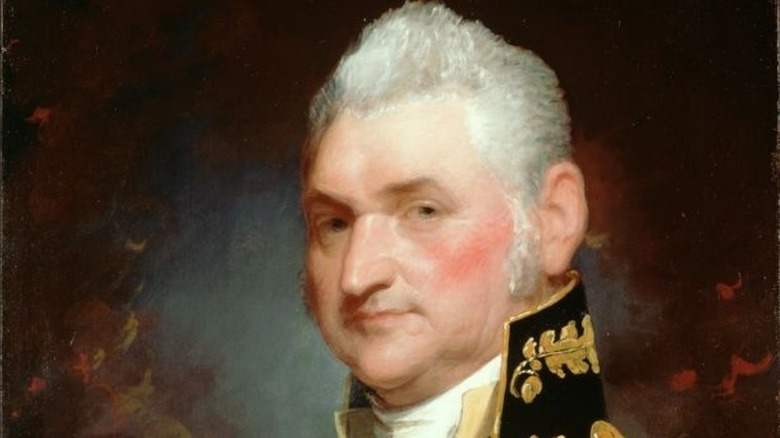This Famous Battle Of Bunker Hill Order Actually Might've Not Been Said
"Don't fire until you see the whites of their eyes!" The visceral, evocative phrase could have been written for a blockbuster action movie's epic battle scene. Instead, for centuries its been attributed to an American commander in the c who supposedly roared the command to the soldiers under his command during the Battle of Bunker Hill in Boston, Massachusetts on June 17, 1775. Per the Journal of the American Revolution, the American rebels had a gunpowder shortage and the famous phrase was meant to tell the soldiers not to fire until the British Redcoats were close enough to be easier targets. The colonists ultimately lost the Battle of Bunker Hill and several soldiers died during the fight and it's suggested that the phrase has become part of the storytelling surrounding the battle that gives the defeated colonists a moral victory for fighting with bravery and passion against enormously stacked odds.
For years, the quote was attributed to Colonel Israel Putnam of Connecticut; this was popularized by the 1808 edition of Parson Mason Weems' bestselling book "The Life of George Washington." Per Weems: "Don't throw away a single shot, my brave fellows," said Old Putnam, "don't throw away a single shot, but take good aim; nor touch a trigger, till you can see the whites of their eyes." Weems didn't include a source for this quote and like his story of young George Washington chopping down a cherry tree and being unable to tell a lie about it, it seems to be an enormously popular bit of "history" lacking proof that it actually happened.
Lots of commanders probably spoke of the whites of eyes
As Teaching History points out, it's likely that more than one military commander uttered the phrase "Don't fire until you see the whites of their eyes" or something like it because 18th-century armies would often be dealing with ammunition shortages, not to mention the inaccuracy of their muskets. A similar phrase is attributed to British General James Wolfe during the French and Indian War as well as Prussian soldiers during the time of Frederick the Great from the 1740s to 1780s.
Revolutionary War Journal reports that, according to several eyewitness accounts of the Battle of Bunker Hill, Israel Putnam wasn't at the front lines at all and was "safely tucked away from harm, some eight hundred yards behind the American line on Bunker Hill." If something like the famous phrase was actually uttered, it's possible it came from Colonel William Prescott (depicted in the print above) who commanded the redoubt at the top of Breed's Hill where troops held off two British attacks before succumbing to the lack of ammunition and retreating.
Don't fire until you see the whites of their ... gaiters?
In fact, thanks to Mason Weems' glowing account in "The Life of George Washington," in 1818 a nationwide debate ensued in response to General Henry Dearborn's (shown above) claims that Putnam should in fact be court-martialed for his behavior during the battle rather than celebrated. Per Revolutionary War Journal, this led to a "war of words" between the Putnam and Dearborn families. One positive outcome of this controversy was writers seeking out oral histories from veterans who had fought in the Battle of Bunker Hill, which led to a richer historical archive of information, but as Weems' book was so popular and known to all interviewees, it's likely that it affected some of the accounts and the "fading recollections" of the soldiers.
To top it all off, colonial soldiers generally fired on the Redcoats at about 50 yards, which would be much too far to be able to see the whites of anyone's eyes. Revolutionary War Journal referenced Nathanial Philbrick's book "Bunker Hill: A City, A Siege, A Revolution" in which he notes that they probably would have used the white half-gaiters British soldiers wore on their shins as targets but "'Don't fire until you see the whites of their half-gaiters' just doesn't have the same ring."


